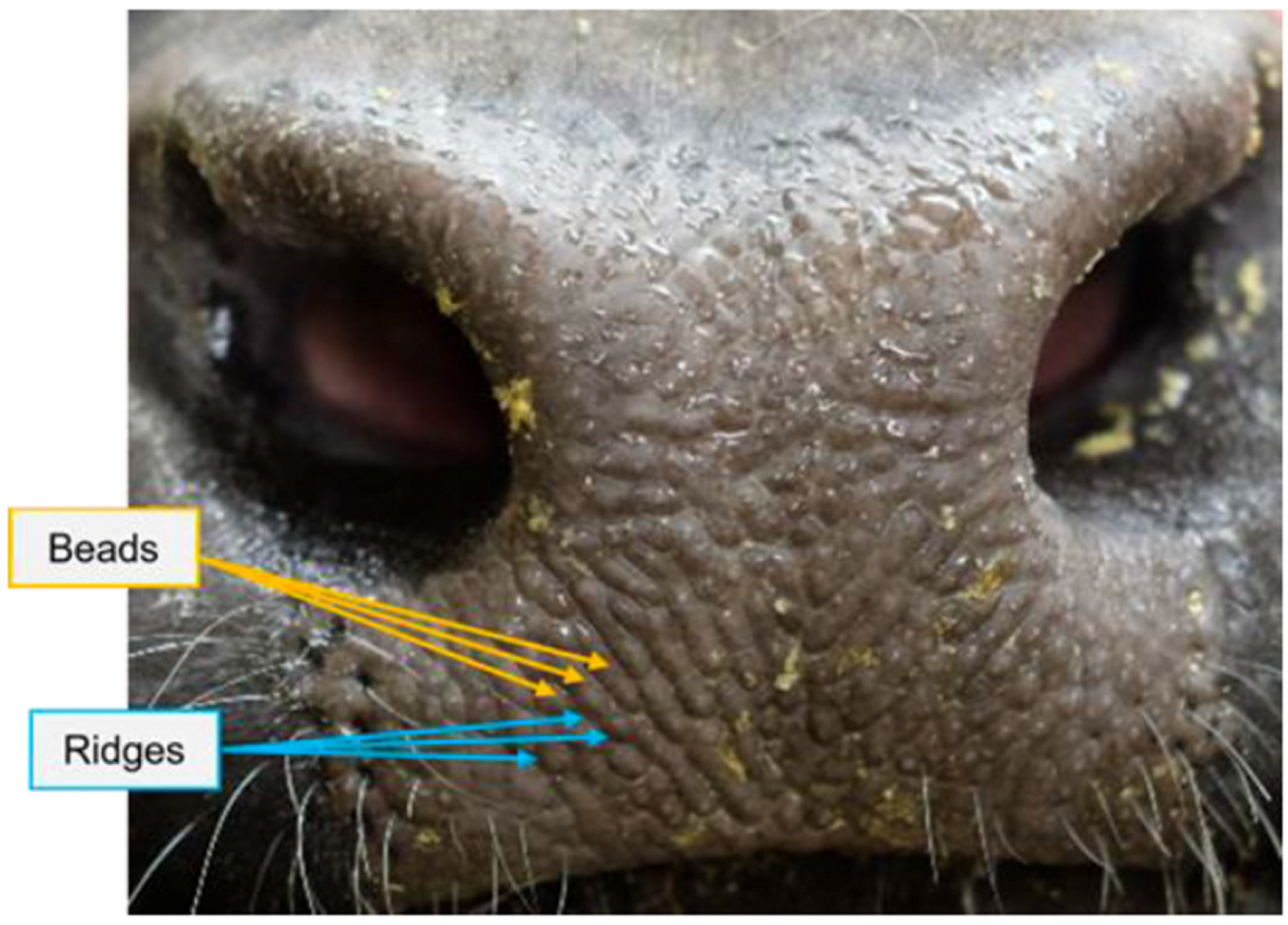Advancements in Individual Animal Identification: A Historical Perspective from Prehistoric Times to the Present
Simple Summary
Abstract
1. Introduction
2. Early Methods
3. Modern Methods
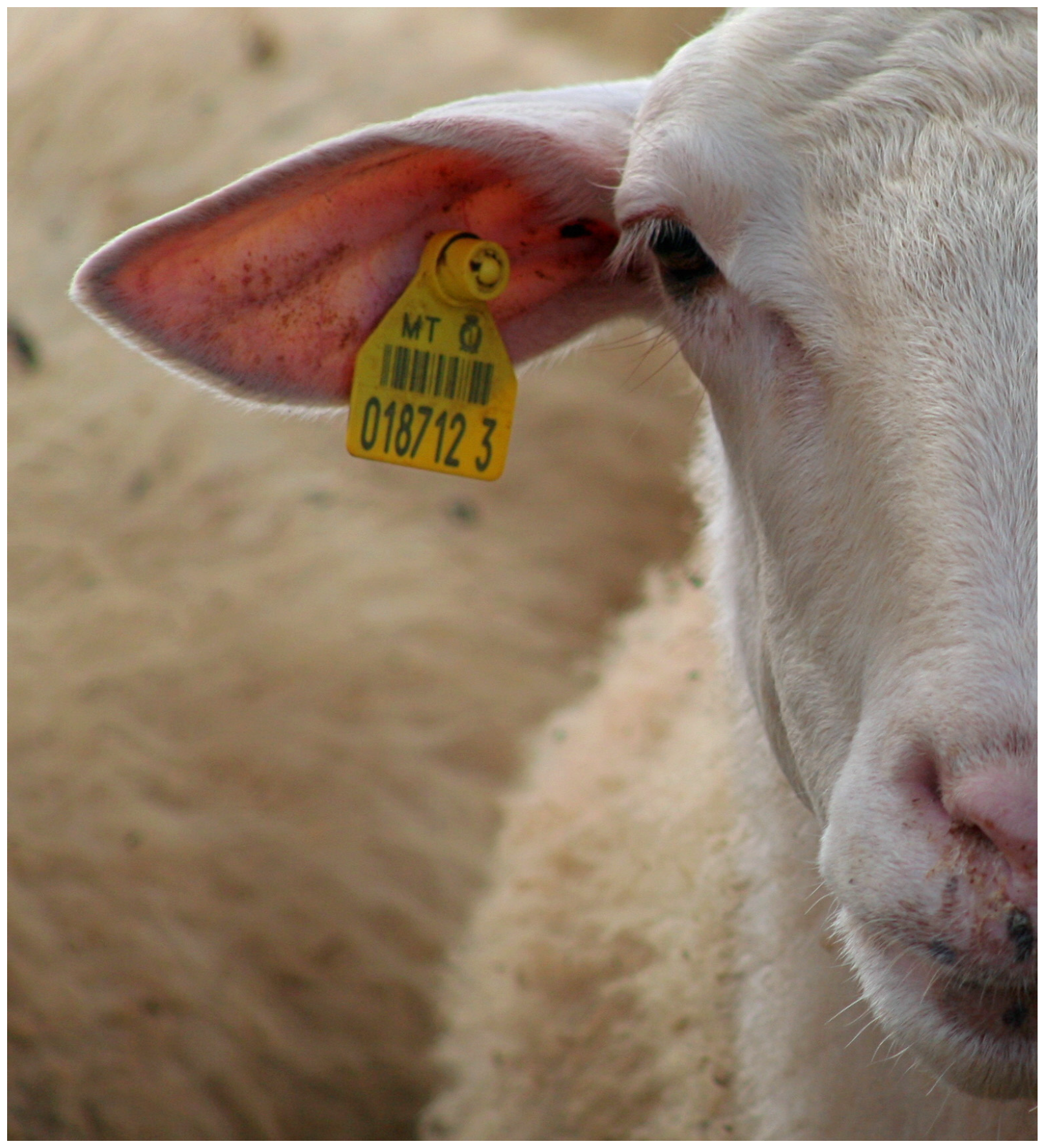
3.1. RFID (Radio Frequency Identification)
3.2. Camera-Based Automatic Identification
4. Used Cases, Feasibility and Resource Needed
5. Ethical Considerations
6. Conclusions
Author Contributions
Funding
Informed Consent Statement
Acknowledgments
Conflicts of Interest
References
- Larson, G.; Fuller, D.Q. The Evolution of Animal Domestication. Annu. Rev. Ecol. Evol. Syst. 2014, 45, 115–136. [Google Scholar] [CrossRef]
- Zeder, M.A. Domestication and Early Agriculture in the Mediterranean Basin: Origins, Diffusion, and Impact. Proc. Natl. Acad. Sci. USA 2008, 105(33), 11597–11604. [Google Scholar] [CrossRef] [PubMed]
- Klerkx, L.; Rose, D. Dealing with the Game-Changing Technologies of Agriculture 4.0: How Do We Manage Diversity and Responsibility in Food System Transition Pathways? Glob. Food Secur. 2020, 24, 100347. [Google Scholar] [CrossRef]
- Poppe, K.; Wolfert, S.; Verdouw, C.; Renwick, A. A European Perspective on the Economics of Big Data. Farm Policy J. 2015, 12, 11–19. [Google Scholar]
- Tuyttens, F.A.M.; Molento, C.F.M.; Benaissa, S. Twelve Threats of Precision Livestock Farming (PLF) for Animal Welfare. Front. Vet. Sci. 2022, 9, 889623. [Google Scholar] [CrossRef]
- Kopler, I.; Marchaim, U.; Tikász, I.E.; Opaliński, S.; Kokin, E.; Mallinger, K.; Neubauer, T.; Gunnarsson, S.; Soerensen, C.; Phillips, C.J.C.; et al. Farmers’ Perspectives of the Benefits and Risks in Precision Livestock Farming in the EU Pig and Poultry Sectors. Animals 2023, 13, 2868. [Google Scholar] [CrossRef]
- Berckmans, D. General Introduction to Precision Livestock Farming. Anim. Front. 2017, 7, 6–11. [Google Scholar] [CrossRef]
- Gómez, Y.; Stygar, A.H.; Boumans, I.J.M.M.; Bokkers, E.A.M.; Pedersen, L.J.; Niemi, J.K.; Pastell, M.; Manteca, X.; Llonch, P. A Systematic Review on Validated Precision Livestock Farming Technologies for Pig Production and Its Potential to Assess Animal Welfare. Front. Vet. Sci. 2021, 8, 660565. [Google Scholar] [CrossRef]
- Geneste, J.-M. From Chauvet to Lascaux: 15,000 Years of Cave Art. Archaeol. Ethnol. Anthropol. Eurasia 2017, 45, 29–40. [Google Scholar] [CrossRef]
- Goulder, J.R. Modern Development Studies as a Resource for Understanding Working Animal Use in Later Human Prehistory: The Example of 4 Th-3 Rd Millennium BC Mesopotamia Volume I. Ph.D. Dissertation, UCL (University College London), London, UK, 2018. [Google Scholar]
- Rajaram, S.; Shelly, C.S. History of Branding. Int. J. Soc. Sci. Interdiscip. Res. 2012, 1, 100–104. [Google Scholar]
- Rapa Das Bestas. Galiza—Category: Livestock Branding—Wikimedia Commons. Available online: https://commons.wikimedia.org/wiki/Category:Livestock_branding#/media/File:Rapa_das_bestas._Galiza.jpg (accessed on 3 August 2025).
- Blancou, J. A History of the Traceability of Animals and Animal Products. Rev. Sci. Tech. 2001, 20, 413–425. [Google Scholar] [CrossRef] [PubMed]
- Bowling, M.B.; Pendell, D.L.; Morris, D.L.; Yoon, Y.; Katoh, K.; Belk, K.E.; Smith, G.C. REVIEW: Identification and Traceability of Cattle in Selected Countries Outside of North America. Prof. Anim. Sci. 2008, 24, 287–294. [Google Scholar] [CrossRef]
- A History of Leg Bands and Ear Tags—National Band and Tag Company. Available online: https://www.nationalband.com/a-history-of-leg-bands-and-ear-tags/ (accessed on 18 August 2025).
- A History of Leg Bands and Ear Tags; National Band and Tag Company: Newport, KY, USA, 2017.
- Vidal, M.; Wolf, N.; Rosenberg, B.; Harris, B.P.; Mathis, A. Perspectives on Individual Animal Identification from Biology and Computer Vision. Integr. Comp. Biol. 2021, 61, 900–916. [Google Scholar] [CrossRef] [PubMed]
- Zhang, Q.; Ahmed, K.; Sharda, N.; Wang, H. A Comprehensive Survey of Animal Identification: Exploring Data Sources, AI Advances, Classification Obstacles and the Role of Taxonomy. Int. J. Intell. Syst. 2024, 2024, 7033535. [Google Scholar] [CrossRef]
- Vlad, M.; Parvulet, R.A.; Vlad, M.S. A Survey of Livestock Identification Systems. In Proceedings of the 13th WSEAS International Conference on Automation and Information, Iasi, Romania, 13–15 June 2012; WSEAS Press: Iasi, Romania, 2012; pp. 165–170. [Google Scholar]
- Sheep Identification—USDA Requirements—4-H Animal Science Resource Blog. Available online: https://4hanimalscience.rutgers.edu/2019/11/04/sheep-identification-and-upcoming-workshop-november-14/ (accessed on 18 July 2025).
- Koelle, A.R.; Bobbett, R.E.; Landt, J.A.; Sanders, W.M.; Holm, D.M.; Depp, S.W. Passive Electronic Iden-Tification and Temperature Monitoring System. Progress Report, July 1, 1974–June 30, 1975 (No. LA-6088-PR). Los Alamos National Lab.(LANL): Los Alamos, NM, USA, 1975. [Google Scholar]
- Roberts, C.M. Radio Frequency Identification (RFID). Comput. Secur. 2006, 25, 18–26. [Google Scholar] [CrossRef]
- Brown-Brandl, T.M.; Adrion, F.; Maselyne, J.; Kapun, A.; Hessel, E.F.; Saeys, W.; Van Nuffel, A.; Gallmann, E. A Review of Passive Radio Frequency Identification Systems for Animal Monitoring in Livestock Facilities. Appl. Eng. Agric. 2019, 35, 579–591. [Google Scholar] [CrossRef]
- Awad, A.I.; Zawbaa, H.M.; Mahmoud, H.A.; Nabi, E.H.H.A.; Fayed, R.H.; Hassanien, A.E. A robust cattle identification scheme using muzzle print images. In Proceedings of the 2013 Federated Conference on Computer Science and Information Systems, Kraków, Poland, 8–11 September 2013; pp. 529–534. [Google Scholar]
- Barry, B.; Gonzales-Barron, U.A.; McDonnell, K.; Butler, F.; Ward, S. Using Muzzle Pattern Recognition as a Biometric Approach for Cattle Identification. Trans. ASABE 2007, 50, 1073–1080. [Google Scholar] [CrossRef]
- Brown-Brandl, T.; Sharma, S.R.; Rohrer, G.; Keel, B.N.; Dennis, K. Development and Implementation of a Precision Livestock Farming System. In Proceedings of the 11th European Conference on Precision Livestock Farming, Bologna, Italy, 9–12 September 2024; pp. 793–800. [Google Scholar]
- Li, G.; Erickson, G.E.; Xiong, Y. Individual Beef Cattle Identification Using Muzzle Images and Deep Learning Techniques. Animals 2022, 12, 1453. [Google Scholar] [CrossRef]
- Guo, Q.; Sun, Y.; Orsini, C.; Bolhuis, J.E.; de Vlieg, J.; Bijma, P.; de With, P.H.N. Enhanced Camera-Based Individual Pig Detection and Tracking for Smart Pig Farms. Comput. Electron. Agric. 2023, 211, 108009. [Google Scholar] [CrossRef]
- Wan, Z.; Tian, F.; Zhang, C. Sheep Face Recognition Model Based on Deep Learning and Bilinear Feature Fusion. Animals 2023, 13, 1957. [Google Scholar] [CrossRef]
- Ferreira, R.E.P.; Bresolin, T.; Rosa, G.J.M.; Dórea, J.R.R. Using Dorsal Surface for Individual Identification of Dairy Calves through 3D Deep Learning Algorithms. Comput. Electron. Agric. 2022, 201, 107272. [Google Scholar] [CrossRef]
- Zhao, K.; Jin, X.; Ji, J.; Wang, J.; Ma, H.; Zhu, X. Individual Identification of Holstein Dairy Cows Based on Detecting and Matching Feature Points in Body Images. Biosyst. Eng. 2019, 181, 128–139. [Google Scholar] [CrossRef]
- Kaur, A.; Kumar, M.; Jindal, M.K. Cattle Identification with Muzzle Pattern Using Computer Vision Technology: A Critical Review and Prospective. Soft. Comput. 2022, 26, 4771–4795. [Google Scholar] [CrossRef]
- Kumar, S.; Singh, S.K.; Singh, R.; Singh, A.K. Animal Biometrics; Springer: Singapore, 2017; ISBN 9789811079559. [Google Scholar]
- Wang, K.; Chen, C.; He, Y. Research on Pig Face Recognition Model Based on Keras Convolutional Neural Network. IOP Conf. Ser. Earth Environ. Sci. 2020, 474, 032030. [Google Scholar] [CrossRef]
- Meng, H.; Zhang, L.; Yang, F.; Hai, L.; Wei, Y.; Zhu, L.; Zhang, J. Livestock Biometrics Identification Using Computer Vision Approaches: A Review. Agriculture 2025, 15, 102. [Google Scholar] [CrossRef]
- Arulmozhi, E.; Bhujel, A.; Moon, B.E.; Kim, H.T. The Application of Cameras in Precision Pig Farming: An Overview for Swine-Keeping Professionals. Animals 2021, 11, 2343. [Google Scholar] [CrossRef]
- Hansen, M.F.; Smith, M.L.; Smith, L.N.; Salter, M.G.; Baxter, E.M.; Farish, M.; Grieve, B. Towards On-Farm Pig Face Recognition Using Convolutional Neural Networks. Comput. Ind. 2018, 98, 145–152. [Google Scholar] [CrossRef]
- Yan, H.; Cui, Q.; Liu, Z. Pig Face Identification Based on Improved AlexNet Model. INMATEH-Agric. Eng. 2020, 61, 97–104. [Google Scholar] [CrossRef]
- Du, Q.; Lu, G.; Tian, L.; Sun, Z.; Wang, Z. Pig Face Recognition Based on Multi Supervising Forms. In Proceedings of the 2023 4th International Conference on Intelligent Computing and Human-Computer Interaction, ICHCI 2023, Guangzhou, China, 4–6 August 2023; pp. 55–58. [Google Scholar] [CrossRef]
- Yang, Q.; Hui, X.; Huang, Y.; Chen, M.; Huang, S.; Xiao, D. A Long-Term Video Tracking Method for Group-Housed Pigs. Animals 2024, 14, 1505. [Google Scholar] [CrossRef]
- Hossain, M.E.; Kabir, M.A.; Zheng, L.; Swain, D.L.; McGrath, S.; Medway, J. A Systematic Review of Machine Learning Techniques for Cattle Identification: Datasets, Methods and Future Directions. Artif. Intell. Agric. 2022, 6, 138–155. [Google Scholar] [CrossRef]
- Qiao, Y.; Su, D.; Kong, H.; Sukkarieh, S.; Lomax, S.; Clark, C. Individual Cattle Identification Using a Deep Learning Based Framework. IFAC-PapersOnLine 2019, 52, 318–323. [Google Scholar] [CrossRef]
- Inadagbo, O.; Makowski, G.; Ahmed, A.A.; Daigle, C. On Developing a Machine Learning-Based Approach for the Automatic Characterization of Behavioral Phenotypes for Dairy Cows Relevant to Thermotolerance. AgriEngineering 2024, 6, 2656–2677. [Google Scholar] [CrossRef]
- Allen, A.; Golden, B.; Taylor, M.; Patterson, D.; Henriksen, D.; Skuce, R. Evaluation of Retinal Imaging Technology for the Biometric Identification of Bovine Animals in Northern Ireland. Livest. Sci. 2008, 116, 42–52. [Google Scholar] [CrossRef]
- Yeleshetty, D.; Spreeuwers, L.; Li, Y. 3D Face Recognition For Cows. In Proceedings of the 2020 International Conference of the Biometrics Special Interest Group (BIOSIG), Darmstadt, Germany, 16–18 September 2020; pp. 163–171. [Google Scholar]
- Eric Psota, R.F.J.H. PICtag: A Practical Approach to Automated Visual Identification of Livestock Animals. In Proceedings of the European Conference on Precision Livestock Farming (ECPLF), Bologna, Italy, 9–12 September 2024; pp. 1342–1349. [Google Scholar]
- Hao, W.; Han, W.; Han, M.; Li, F. A Novel Improved YOLOv3-SC Model for Individual Pig Detection. Sensors 2022, 22, 8792. [Google Scholar] [CrossRef] [PubMed]
- Psota, E.T.; Schmidt, T.; Mote, B.; Pérez, L.C. Long-Term Tracking of Group-Housed Livestock Using Keypoint Detection and Map Estimation for Individual Animal Identification. Sensors 2020, 20, 3670. [Google Scholar] [CrossRef] [PubMed]
- Pérez-Escudero, A.; Vicente-Page, J.; Hinz, R.C.; Arganda, S.; De Polavieja, G.G. IdTracker: Tracking Individuals in a Group by Automatic Identification of Unmarked Animals. Nat. Methods 2014, 11, 743–748. [Google Scholar] [CrossRef]
- van der Zande, L.E.; Guzhva, O.; Rodenburg, T.B. Individual Detection and Tracking of Group Housed Pigs in Their Home Pen Using Computer Vision. Front. Anim. Sci. 2021, 2, 669312. [Google Scholar] [CrossRef]
- Liu, Y.; Li, W.; Liu, X.; Li, Z.; Yue, J. Deep Learning in Multiple Animal Tracking: A Survey. Comput. Electron. Agric. 2024, 224, 109161. [Google Scholar] [CrossRef]
- Bhople, A.R.; Shrivastava, A.M.; Prakash, S. Point Cloud Based Deep Convolutional Neural Network for 3D Face Recognition. Multimed. Tools Appl. 2021, 80, 30237–30259. [Google Scholar] [CrossRef]
- Zhang, X.; Xuan, C.; Ma, Y.; Su, H. A High-Precision Facial Recognition Method for Small-Tailed Han Sheep Based on an Optimised Vision Transformer. Animal 2023, 17, 100886. [Google Scholar] [CrossRef]
- Karimi Monsefi, A.; Khurana, M.; Ramnath, R.; Karpatne, A.; Chao, W.-L.; Zhang, C. TaxaDiffusion: Progressively Trained Diffusion Model for Fine-Grained Species Generation. arXiv 2025, arXiv:2506.01923. [Google Scholar]
- Paudel, S.; Brown-Brandl, T. From Ancient Marks to Modern Technology: The Evolution of Pig Identification. In Proceedings of the US Precision Livestock Farming, Lincoln, OR, USA, 2 June 2025. [Google Scholar]
- Sharma, A.; Randewich, L.; Andrew, W.; Hannuna, S.; Campbell, N.; Mullan, S.; Dowsey, A.W.; Smith, M.; Hansen, M.; Burghardt, T. Universal Bovine Identification via Depth Data and Deep Metric Learning. Comput. Electron. Agric. 2025, 229, 109657. [Google Scholar] [CrossRef]
- Marsot, M.; Mei, J.; Shan, X.; Ye, L.; Feng, P.; Yan, X.; Li, C.; Zhao, Y. An Adaptive Pig Face Recognition Approach Using Convolutional Neural Networks. Comput. Electron. Agric. 2020, 173, 105386. [Google Scholar] [CrossRef]
- Barton, R.; Burchard, J.; Cabrera, V.E.; Cook, D.; Cooley, W.; Cue, R.; Fadul, L.; Mattison, J.; Saha, A. Data Ownership and Privacy in Dairy Farming: Insights from U.S. and Global Perspectives. Animals 2025, 15, 524. [Google Scholar] [CrossRef] [PubMed]
- Neethirajan, S. Safeguarding Digital Livestock Farming—A Comprehensive Cybersecurity Roadmap for Dairy and Poultry Industries. Front. Big Data 2025, 8, 1556157. [Google Scholar] [CrossRef]
- Tulloch, L.; Judge, P. Bringing the Calf Back from the Dead: Video Activism, the Politics of Sight and the New Zealand Dairy Industry. Video J. Educ. Pedagog. 2018, 3, 9. [Google Scholar] [CrossRef]
- U.S. Department of Agriculture, Animal and Plant Health Inspection Service. Advancing Animal Disease Traceability: Three Year Road Map for Washington State (D. Hecimovich, A. J. Itle, & M. E. Gibson, Contributors). Available online: https://www.aphis.usda.gov/sites/default/files/wa-roadmap.pdf (accessed on 1 April 2024).
- Skaggs, R. The US National Animal Identification System (NAIS) & the US Beef-Cattle Sector: A Post-Mortem Analysis of NAIS. In Deploying RFID-Challenges, Solutions, and Open Issues; IntechOpen: London, UK, 2011; ISBN 9533073802. [Google Scholar]
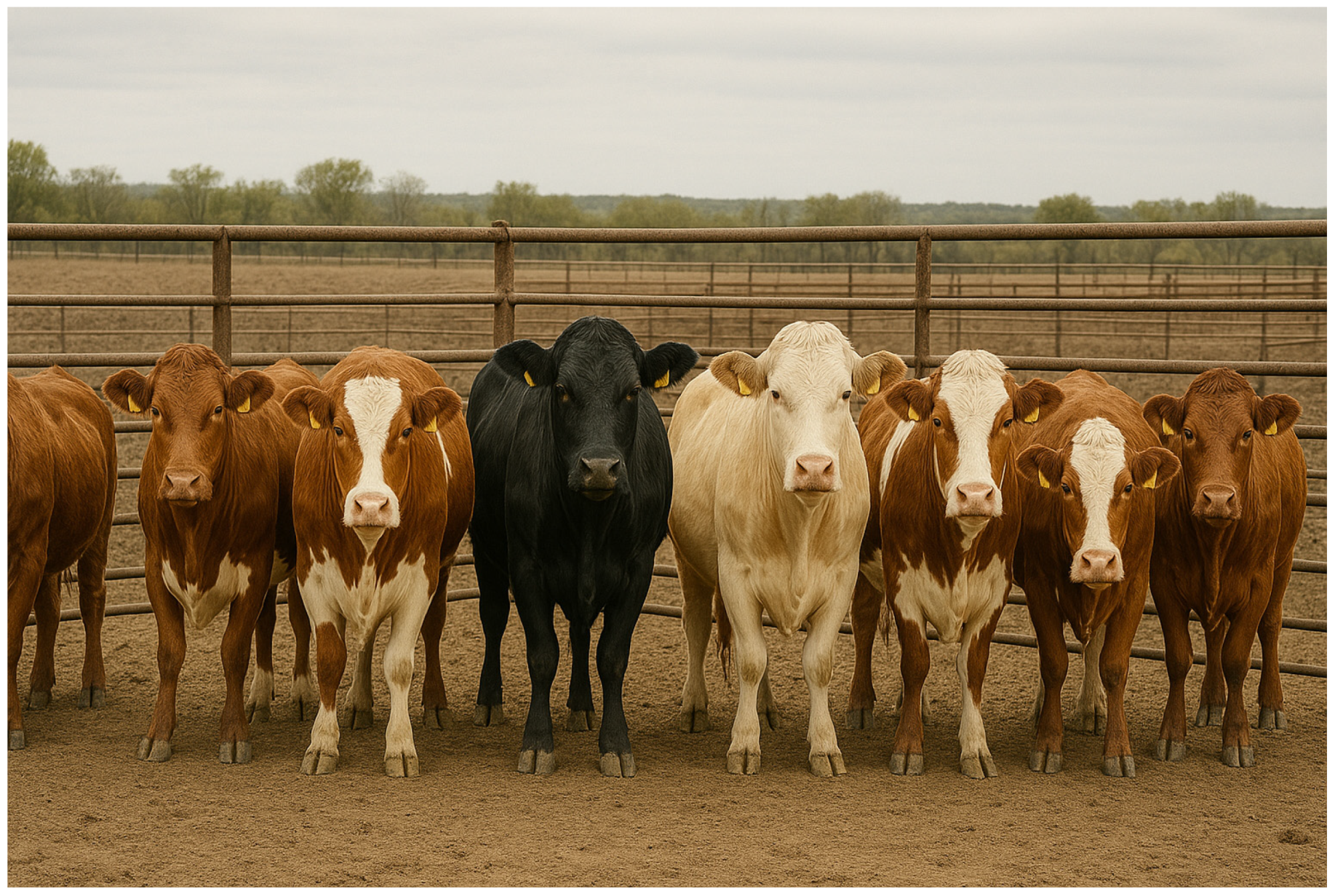
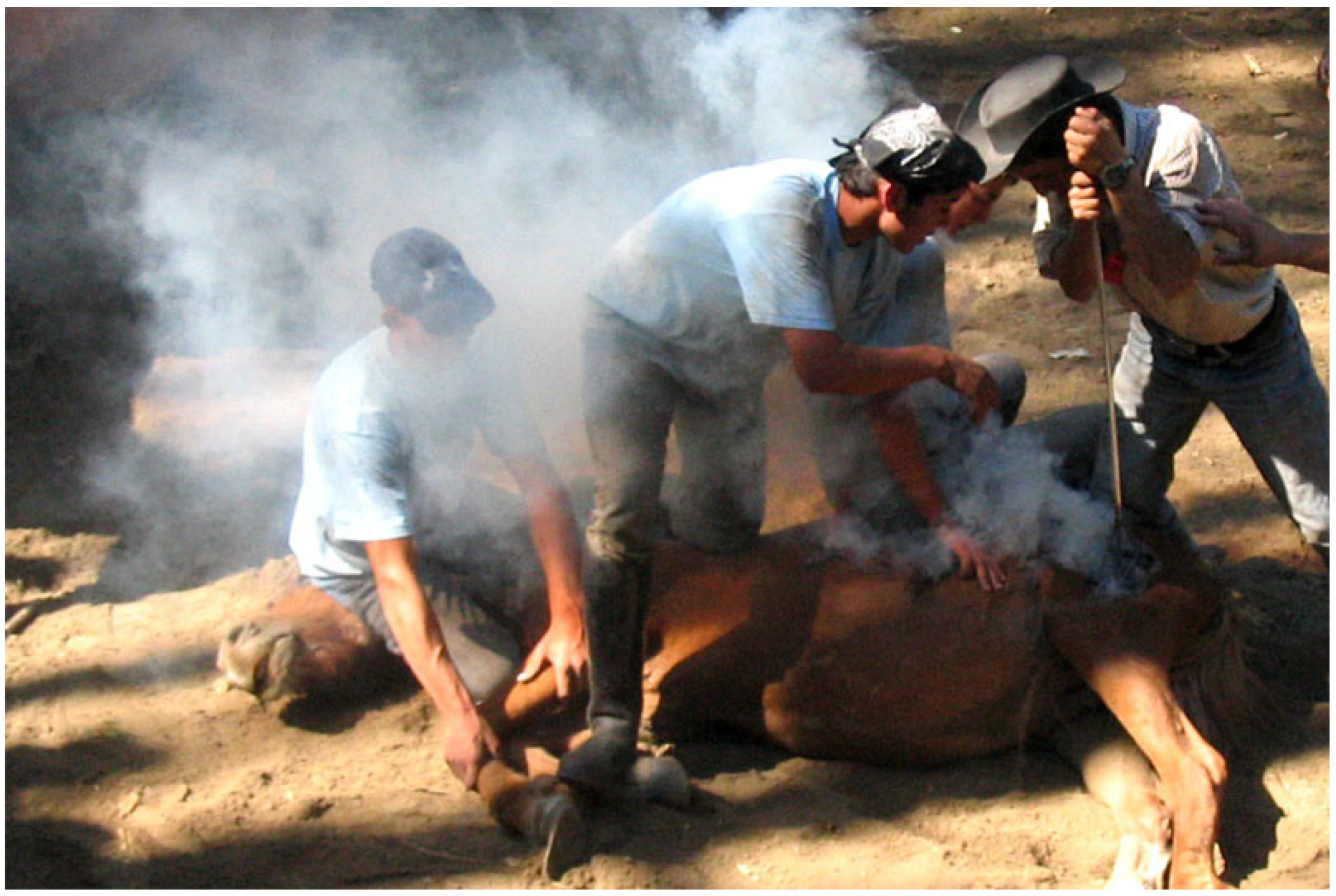
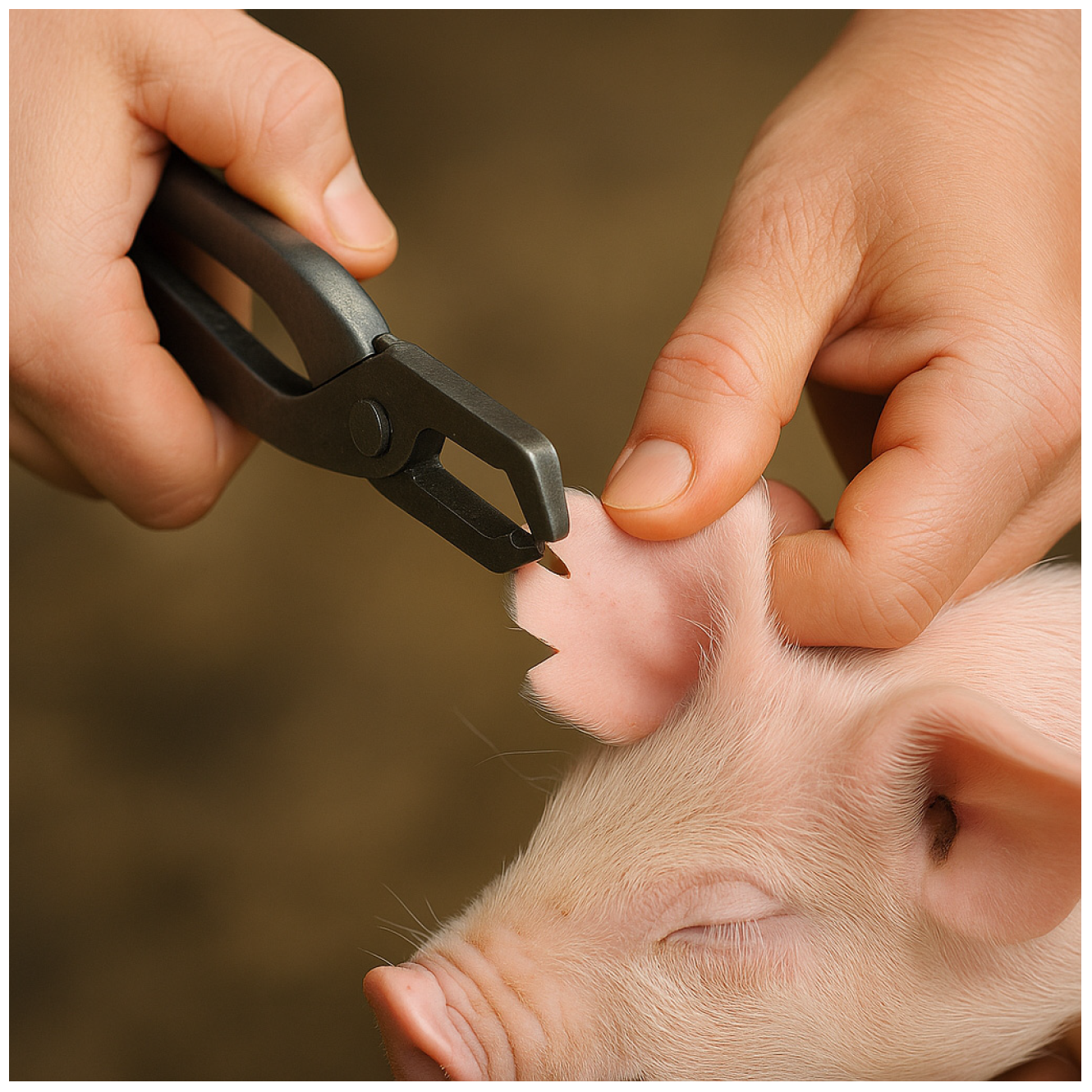
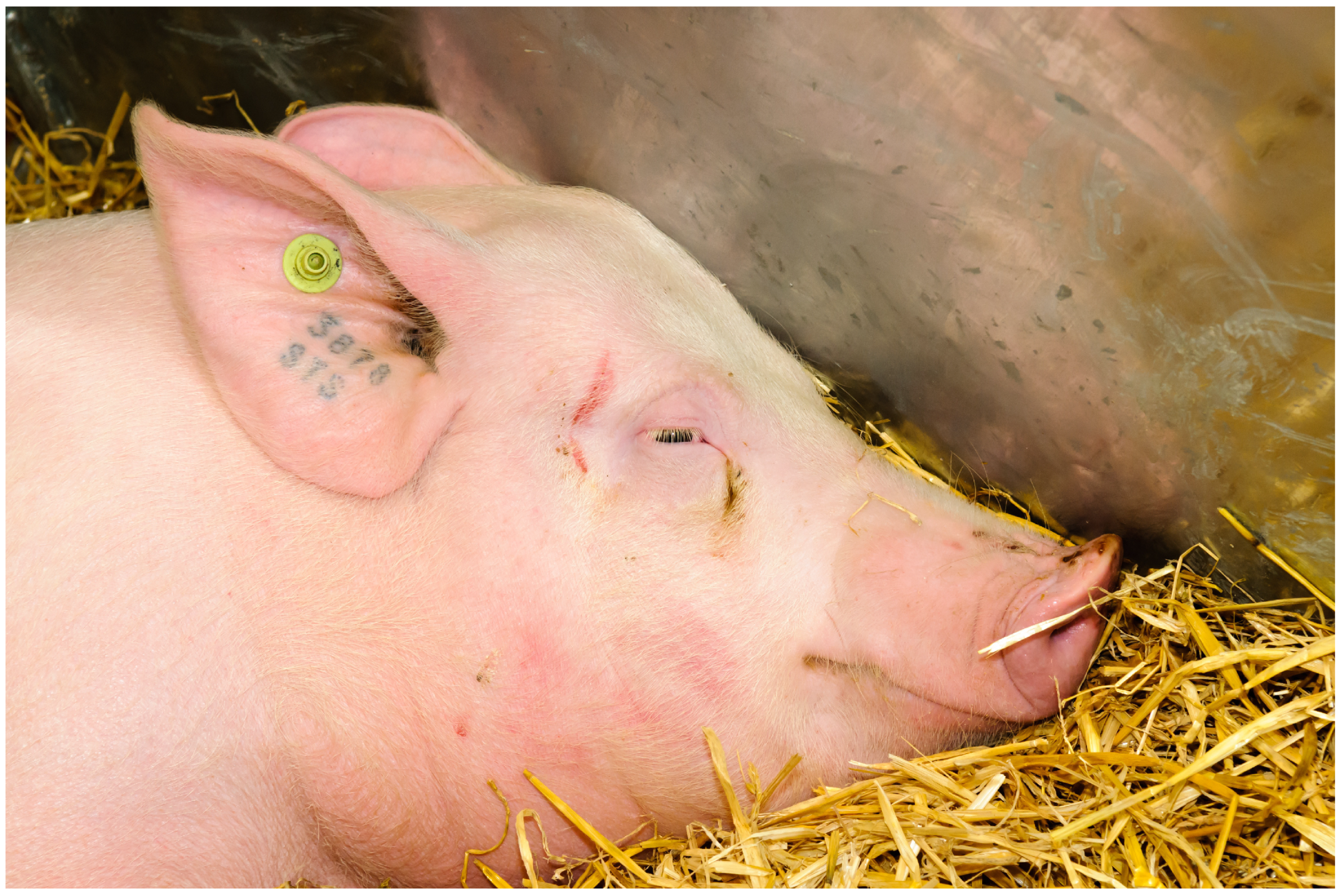

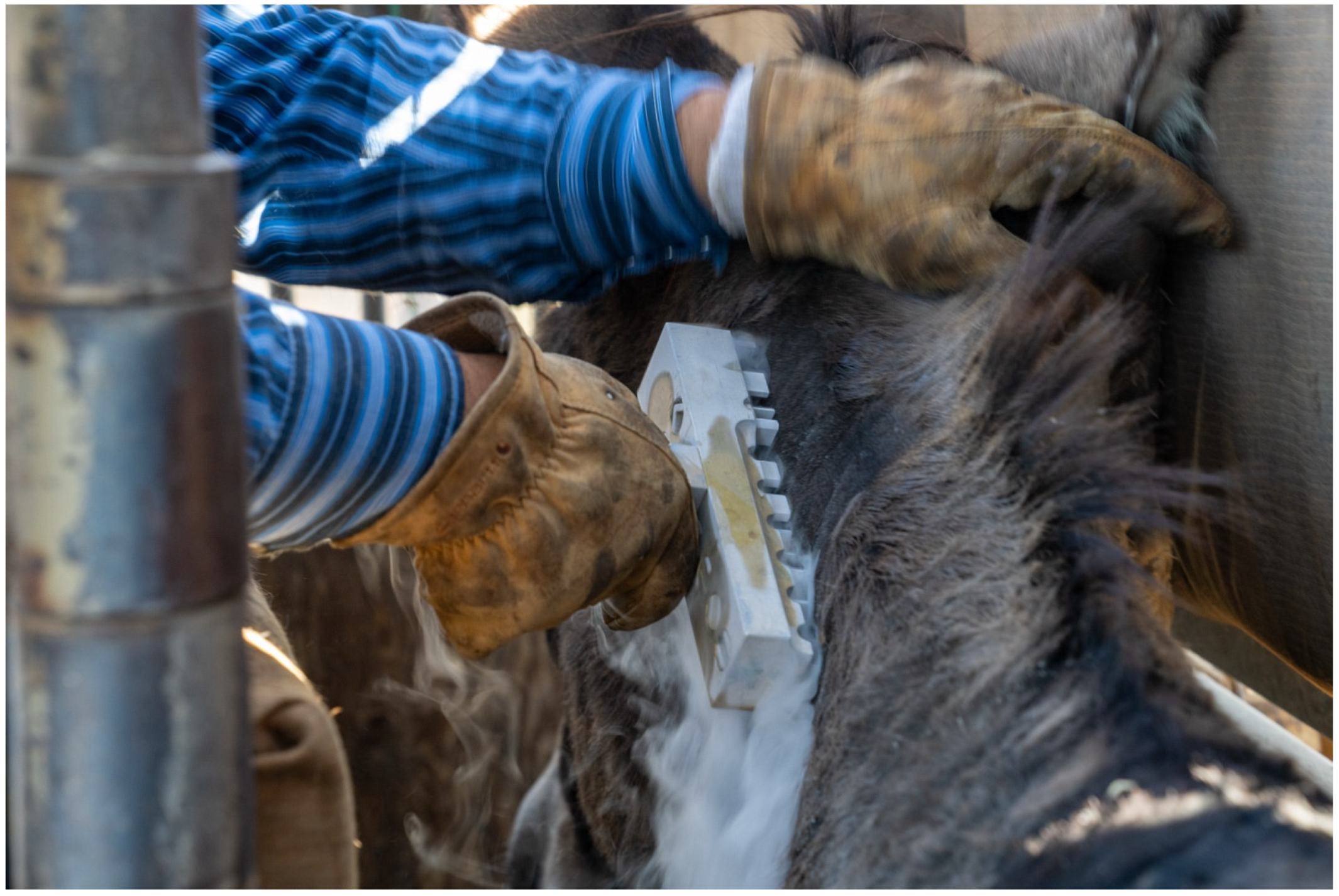
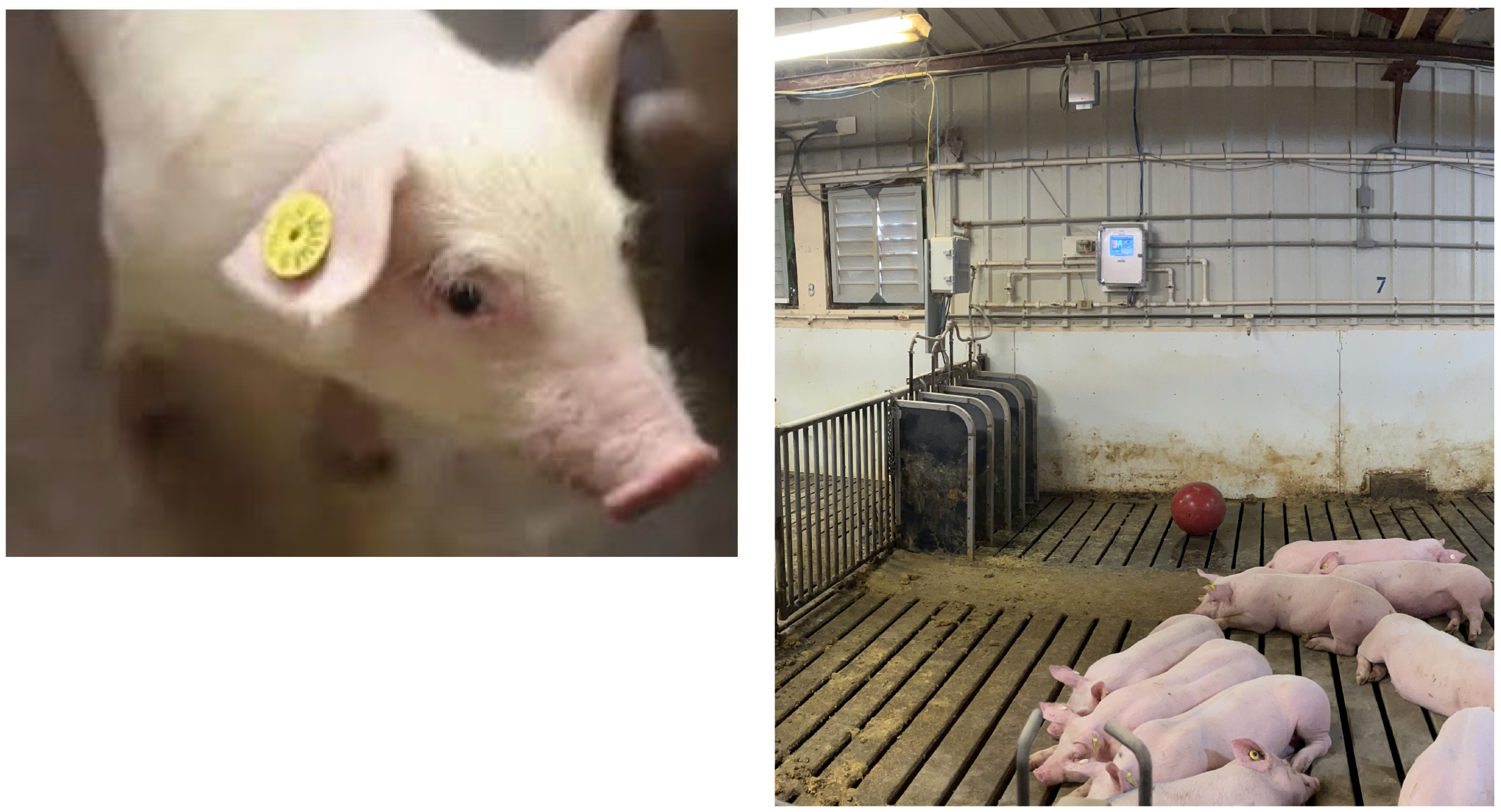
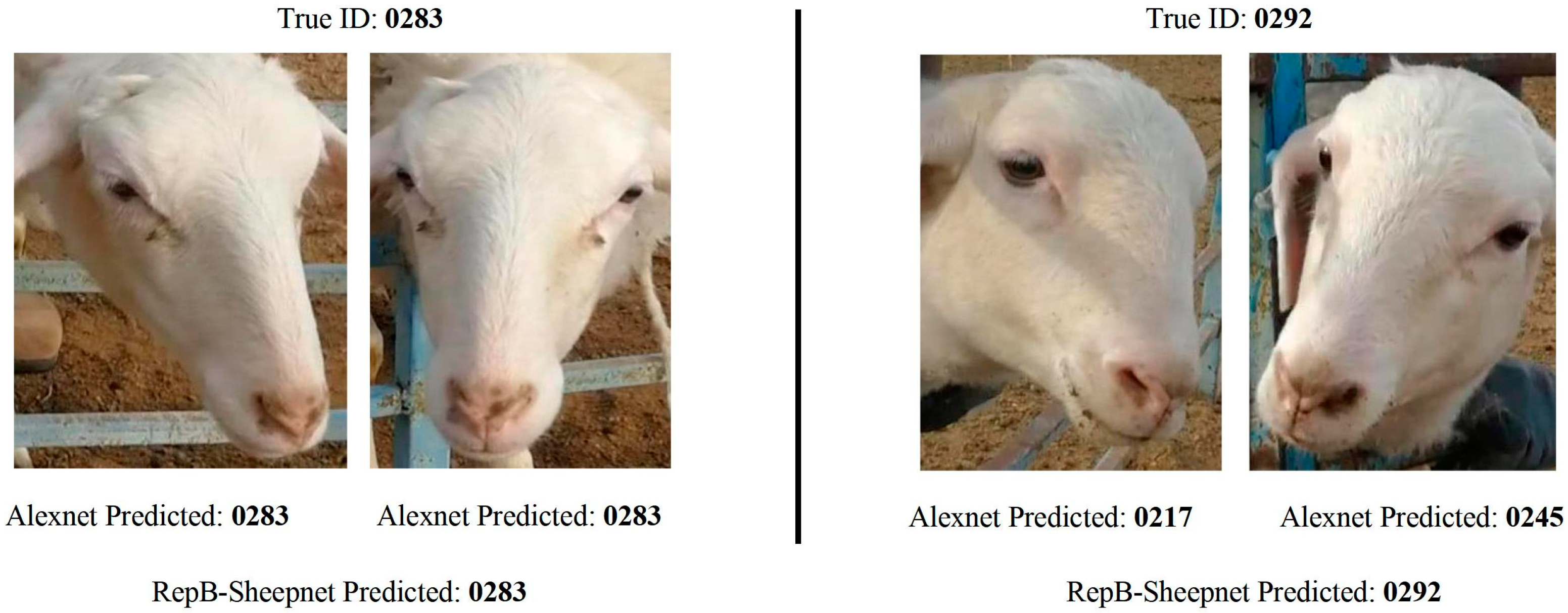
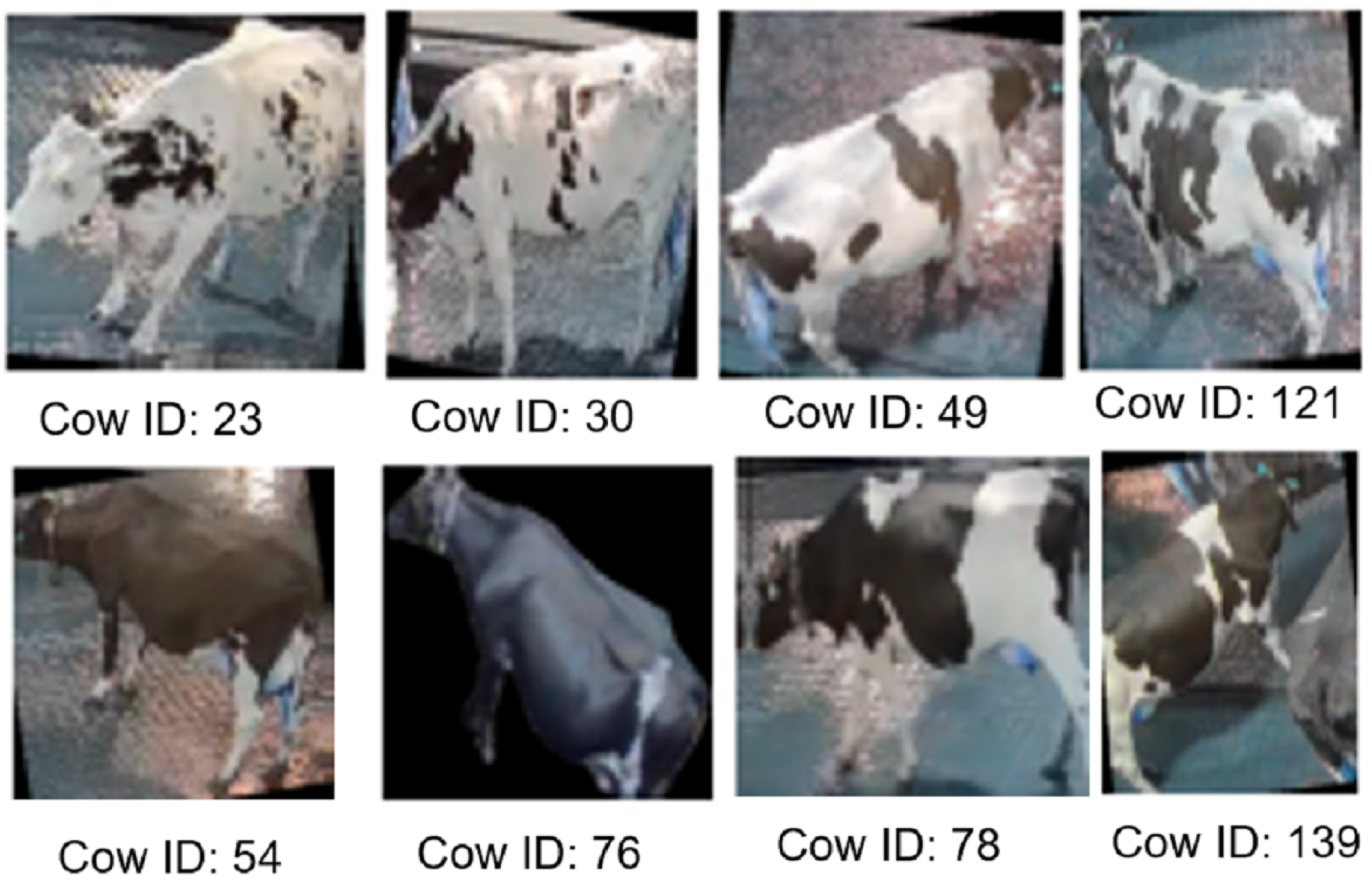
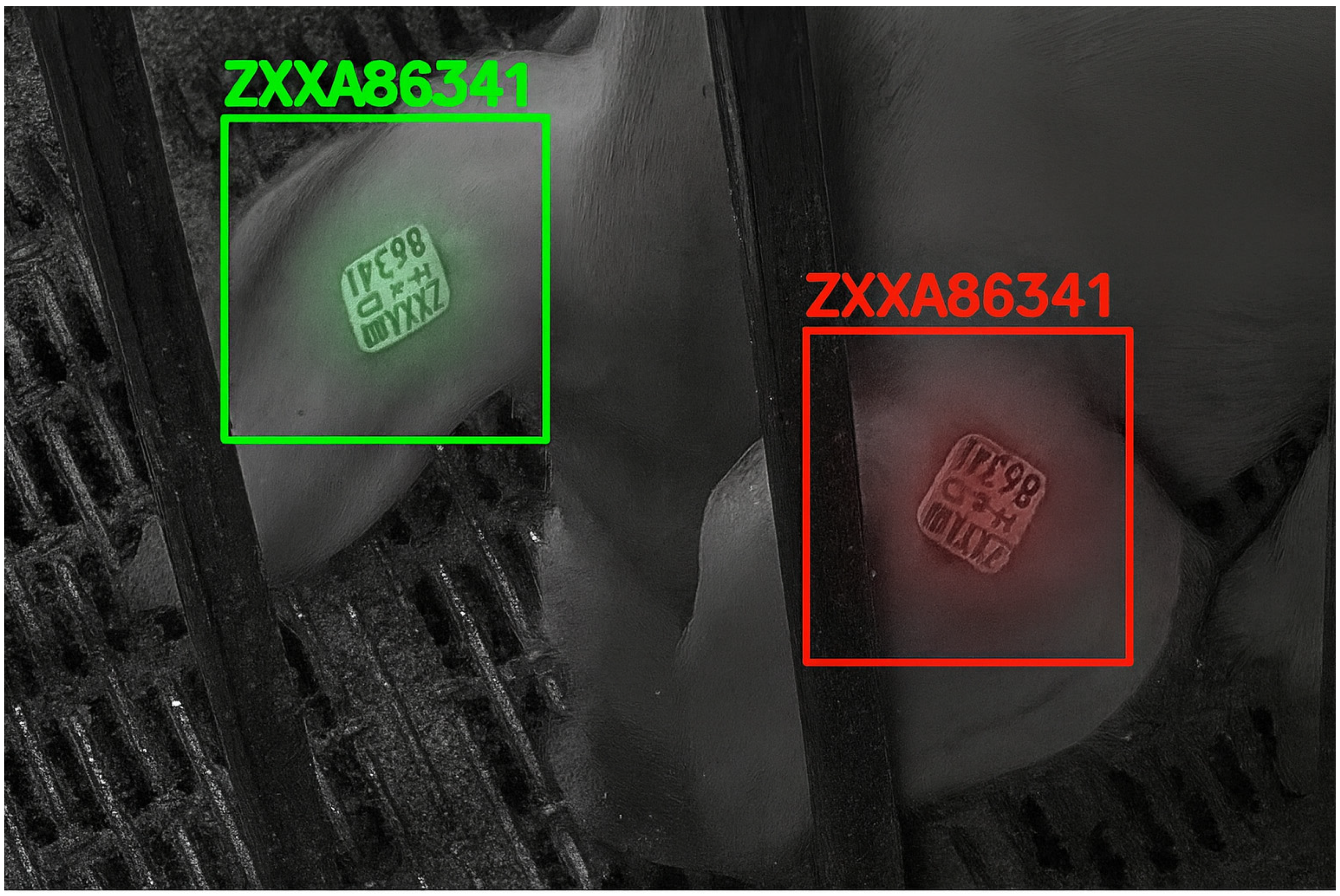
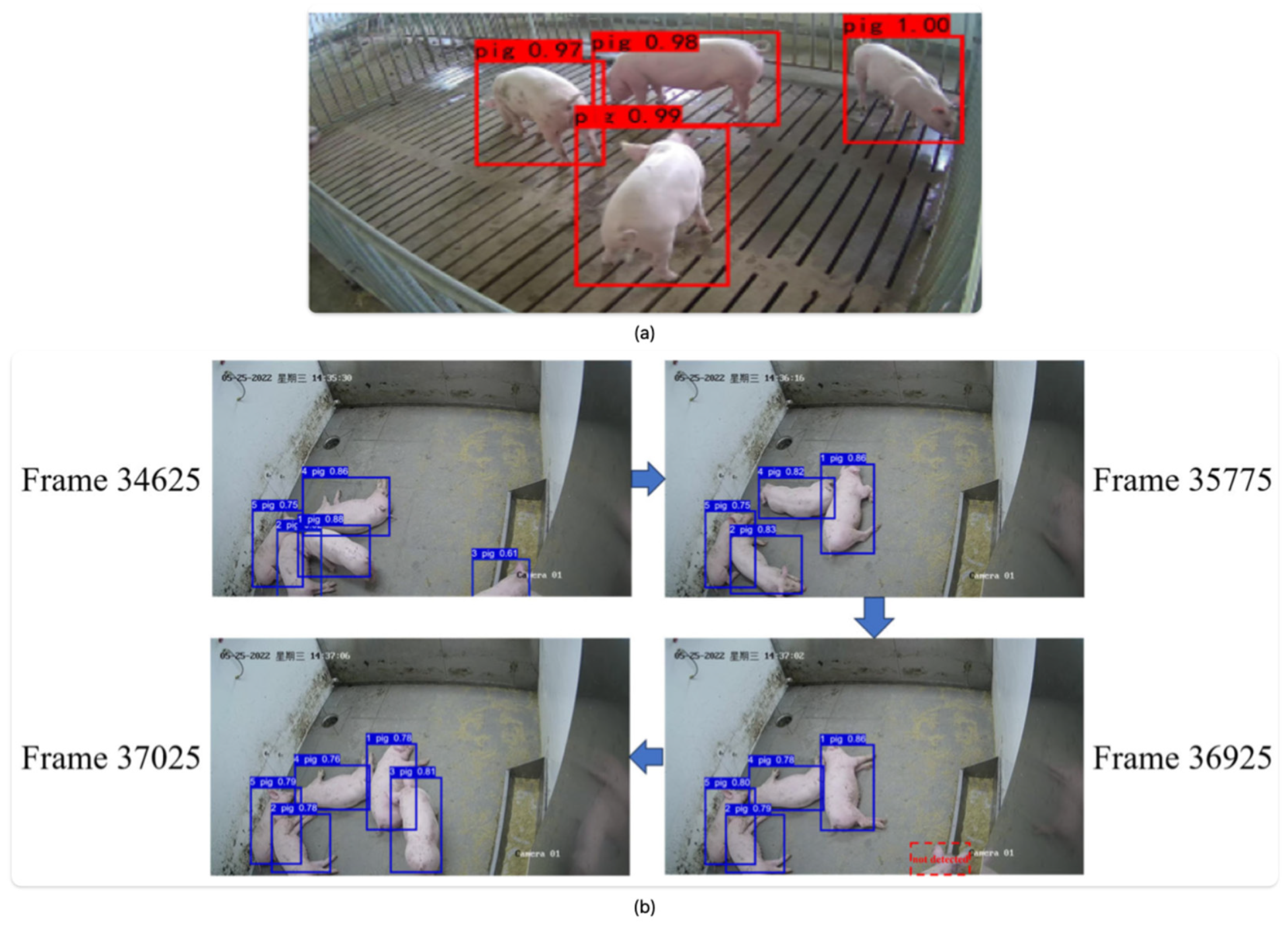
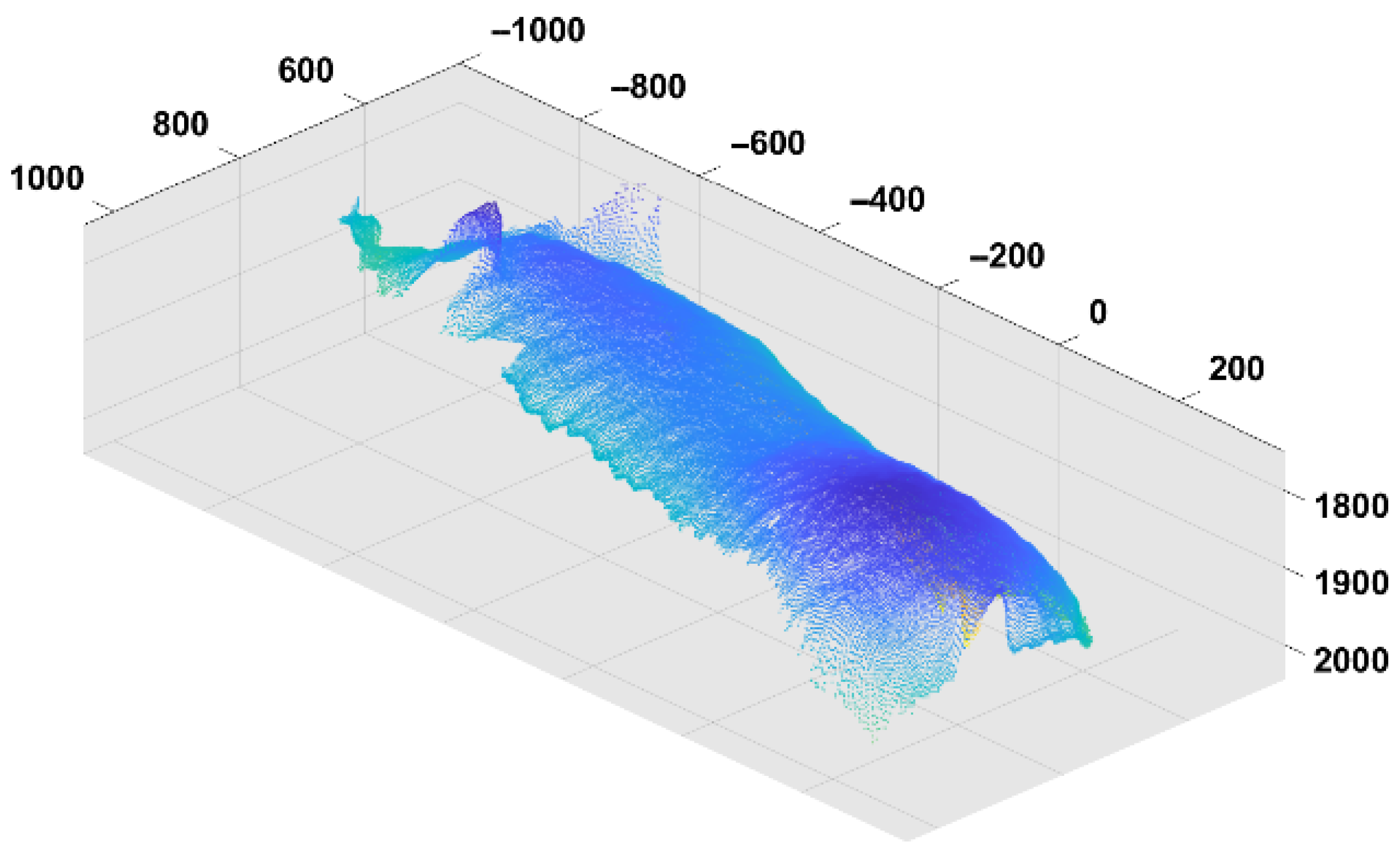
| Frequency Bands | Antenna | Data and Speed | Read Range | Usage |
|---|---|---|---|---|
| Low Frequency (LF) 125 kHz, 134 kHz | Induction Coil on Ferrite Core, or flat many turns | Low Read Speeds—Small Amount of Data (16 bits) | Short to Medium 3–5 feel |
|
| High Frequency (HF) 13.56 MHz | Induction Coil flat 3–9 turns | Medium Read Speed Small to Medium amounts of Data | Short 1–3 feet |
|
| Very High Frequency (VHF) 433 MHz—Active Tags | Internal Custom Design | High Read Speed Large Amount of Data | High 1–1000 feet |
|
| Ultra-High Frequency (UHF) 860 MHz—960 MHz | Single or Double Dipole | High Read Speed Small to Medium Amount of Data | Medium 1–30 feet |
|
| Microwave Frequency 2.45 GHz and 5.4 GHz | Single Dipole | High Read Speed Medium Amount of Data | High 1–300 feet |
|
| Low frequency | High Frequency | Ultra High Frequency | |
|---|---|---|---|
| Typical frequency used in livestock | 132.4 kHz | 13.56 MHz | 866–868 MHz (EU), 902–928 MHz (US) |
| Reading range | 0–80 cm | 0–1 m | 0 cm to 12 m, up to 25 m under certain conditions |
| Tags available for livestock | Yes | Yes, but very limited selection or from other applications | Yes, but limited selection |
| Data rate | 4 to 8 kbps | 6.7 to 848 kbps | 20 to 300 kbps |
| Transponder read per second | <10 | >10 | >100 |
| Water interference (proximity of tag) | No | Low | Strong (absorption) |
| Metal interference (reading environment) | Low | High | High (reflections and interferences) |
| Metal interference (proximity of reader antenna) | High | High | High |
Disclaimer/Publisher’s Note: The statements, opinions and data contained in all publications are solely those of the individual author(s) and contributor(s) and not of MDPI and/or the editor(s). MDPI and/or the editor(s) disclaim responsibility for any injury to people or property resulting from any ideas, methods, instructions or products referred to in the content. |
© 2025 by the authors. Licensee MDPI, Basel, Switzerland. This article is an open access article distributed under the terms and conditions of the Creative Commons Attribution (CC BY) license (https://creativecommons.org/licenses/by/4.0/).
Share and Cite
Paudel, S.; Brown-Brandl, T. Advancements in Individual Animal Identification: A Historical Perspective from Prehistoric Times to the Present. Animals 2025, 15, 2514. https://doi.org/10.3390/ani15172514
Paudel S, Brown-Brandl T. Advancements in Individual Animal Identification: A Historical Perspective from Prehistoric Times to the Present. Animals. 2025; 15(17):2514. https://doi.org/10.3390/ani15172514
Chicago/Turabian StylePaudel, Shiva, and Tami Brown-Brandl. 2025. "Advancements in Individual Animal Identification: A Historical Perspective from Prehistoric Times to the Present" Animals 15, no. 17: 2514. https://doi.org/10.3390/ani15172514
APA StylePaudel, S., & Brown-Brandl, T. (2025). Advancements in Individual Animal Identification: A Historical Perspective from Prehistoric Times to the Present. Animals, 15(17), 2514. https://doi.org/10.3390/ani15172514





